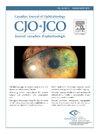小儿 MOGAD 视神经炎患者 OCT 和 MRI 检查结果的单中心回顾性系列研究。
IF 3.3
4区 医学
Q1 OPHTHALMOLOGY
Canadian journal of ophthalmology. Journal canadien d'ophtalmologie
Pub Date : 2024-08-22
DOI:10.1016/j.jcjo.2024.07.021
引用次数: 0
摘要
背景:光学计算机断层扫描(OCT)和磁共振成像(MRI)结果是否与髓鞘少突胶质细胞糖蛋白抗体病(MOGAD)视神经炎患儿的最终视力相关尚不清楚:我们回顾性地查看了自2016年以来在圣路易斯儿童医院/巴恩斯犹太医院就诊的MOGAD视神经炎儿童患者的病历:在本研究的12名患者中,视神经炎受累眼的视力较差,但从发病到随访期间视力明显改善,因此在最后一次随访时,受累眼与未受累眼之间不再存在统计学差异。从发病到随访期间,出现神经强化的患眼数量、受影响的视神经数量以及视网膜神经纤维层(RNFL)、神经节细胞层(GCL)和黄斑的厚度均有所下降。最终,这些变量均与最终视力无关:结论:在该队列中,尽管核磁共振成像显示视网膜神经纤维层(RNFL)明显变薄且视神经受累,但小儿MOGAD视神经炎患者的视力结果良好,这导致随访视力与OCT和核磁共振成像对疾病严重程度的测量结果之间缺乏相关性。本文章由计算机程序翻译,如有差异,请以英文原文为准。
A single-center retrospective series of OCT and MRI findings in pediatric MOGAD optic neuritis patients
Background
Whether optical computed tomography (OCT) and magnetic resonance imaging (MRI) findings are associated with final visual acuity in children with myelin oligodendrocyte glycoprotein antibody disease (MOGAD) optic neuritis is unclear.
Methods
We retrospectively reviewed the charts of pediatric patients with MOGAD optic neuritis seen at St. Louis Children's Hospital/Barnes Jewish Hospital since 2016.
Results
In the 12 patients in this study, presenting visual acuity was worse in the optic neuritis-affected eyes but significantly improved from presentation to follow-up, such that, at last follow-up, there was no longer a statistical difference between the affected and unaffected eyes. The number of affected eyes with nerve enhancement and the amount of optic nerve affected, as well as thickness of the retinal nerve fiber layer (RNFL), ganglion cell layer (GCL), and macula, decreased from presentation to follow-up. Ultimately, none of these variables were associated with final visual acuity.
Conclusion
In this cohort, pediatric MOGAD optic neuritis patients had positive visual outcomes despite significant RNFL thinning and involvement of the optic nerve on MRI, leading to a lack of correlation between follow-up visual acuity and OCT and MRI measures of disease severity, respectively.
Contexte
On ignore s'il existe un lien explicite entre les résultats des examens d'imagerie (tomographie par cohérence optique [OCT] et imagerie en résonance magnétique [IRM]) et l'acuité visuelle finale chez des enfants présentant une névrite optique associée aux anticorps anti-glycoprotéine de la myéline oligodendrocytaire (MOG).
Méthodes
Nous avons procédé à un examen rétrospectif des dossiers médicaux d'enfants présentant une névrite optique associée aux anticorps anti-glycoprotéine de la MOG traités au St. Louis Children's Hospital/Barnes Jewish Hospital depuis 2016.
Résultats
L'acuité visuelle initiale des 12 patients de notre étude était pire dans les yeux atteints d'une névrite optique et s'est améliorée significativement pendant le suivi, de sorte qu'il n'existait plus de différence statistique entre les yeux atteints et les yeux sains lors de la dernière visite de suivi. Le nombre d'yeux touchés qui présentaient une intensification du nerf optique, la portion du nerf optique atteint de même que l’épaisseur de la couche de fibres nerveuses rétiniennes, de la couche de cellules ganglionnaires et de la macula ont tous diminué entre la visite initiale et le suivi. Finalement, aucune de ces variables n'a été associée à l'acuité visuelle finale.
Conclusion
Cette cohorte d'enfants porteurs d'une névrite optique associée aux anticorps anti-glycoprotéine de la MOG a eu des résultats visuels positifs malgré l'amincissement significatif de la couche de fibres nerveuses rétiniennes et l'atteinte du nerf optique visibles à l'IRM. Nous avons donc conclu à l'absence de corrélation entre l'acuité visuelle lors du suivi et les mesures de la gravité de l'atteinte obtenues à l'OCT et à l'IRM, respectivement.
求助全文
通过发布文献求助,成功后即可免费获取论文全文。
去求助
来源期刊
CiteScore
3.20
自引率
4.80%
发文量
223
审稿时长
38 days
期刊介绍:
Official journal of the Canadian Ophthalmological Society.
The Canadian Journal of Ophthalmology (CJO) is the official journal of the Canadian Ophthalmological Society and is committed to timely publication of original, peer-reviewed ophthalmology and vision science articles.

 求助内容:
求助内容: 应助结果提醒方式:
应助结果提醒方式:


